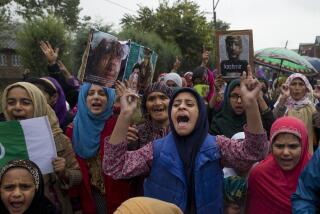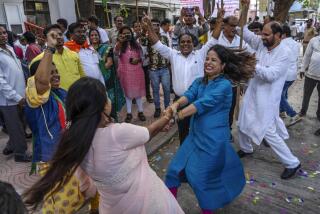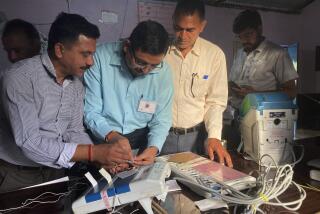Violence Rampant as India Starts Voting : Elections: The official death toll for the first of three days of balloting is at least 38. Turnout is just 50%.
- Share via
AHROURA, India — Dozens of voters were shot, beaten or stabbed to death in election-day clashes throughout northern India on Monday, while thousands of low-caste Hindus and other minorities were physically barred from voting through widespread intimidation and poll fraud as the Indian nation began its crucial, weeklong parliamentary elections.
Initial reports Monday night put the opening-day voter turnout at just 50%, the lowest in India’s 44 years of electoral history. Most analysts attributed the low turnout to the brutal summer heat and to a sense of dread and cynicism among the voters who constitute a nation traditionally called the world’s largest democracy.
The official death toll late Monday from the first of India’s three days of staggered voting stood at more than 38. Most of them were killed in the violence-prone north Indian states of Uttar Pradesh and Bihar during religious battles that raged throughout the day between India’s majority Hindus and its Muslim minority and in clashes between Hinduism’s powerful higher castes and the increasingly assertive lower castes known as untouchables.
Polling in the nation’s capital and in eight other regions was largely peaceful, and the country’s phased voting is scheduled to continue on Thursday and Sunday, with final tallies beginning only next Monday.
But the violence, which erupted despite the deployment of tens of thousands of police and paramilitary troops, included armed confrontations sponsored by all four major national parties seeking a majority in the 545-seat National Assembly. And it climaxed a bitter, six-week campaign that already had left 115 dead and India deeply polarized along religious lines.
Monday’s killings also came at the start of an election process that most analysts viewed as a watershed for independent India, a period of unprecedented political instability and economic uncertainty that some have said could threaten the nation’s foundation as a democratic state.
For the first time since India’s independence in 1947, an openly Hindu revivalist party, the Bharatiya Janata Party, is challenging the traditional power of the long-ruling Congress-I Party, now headed by former Prime Minister Rajiv Gandhi, the third generation of elected rulers in the political dynasty begun by Jawaharlal Nehru.
Throughout its campaign, the Janata party has used a populist religious crusade to build a temple to the Hindu demigod Lord Rama on the precise spot where an ancient Islamic mosque now stands. The call for the temple has been the main rallying cry for India’s 750 million Hindus to unite and vote as a political bloc for the first time.
The Congress-I, which helped build India into a developing state that is not only democratic but also constitutionally socialist and secular, has retaliated bitterly, with Gandhi asserting that the right-wing fundamentalist campaign will tear India apart.
It was in brutal clashes between poll watchers and campaign workers from the two parties--in many cases, Hindus and Muslims squaring off against each other--that most of Monday’s election carnage occurred, and most of it during shootouts, arson sprees and knife fights in Uttar Pradesh, the nation’s most populous and religiously polarized state and the site of the temple-mosque controversy.
In one case, police opened fire and imposed a 24-hour curfew in the city of Meerut, and officials suspended polling in much of the city, after the street fights plunged the local vote into chaos. In another case, in the state’s Bulandshahr District, a 3-year-old boy was gunned down in a cross-fire.
But at least 10 others were killed Monday in the neighboring state of Bihar, by far India’s poorest and most feudal region and one long ruled by heavily armed “mafia dons.” And during a 10-hour election tour of central Bihar, where voters braved not only bullets but scorching temperatures of more than 110 degrees, The Times found that most of the bloodshed was directly related to clashes over caste, another explosive and divisive election issue equally exploited by all four parties during the campaign.
The Congress-I, long a professed champion and vote-beneficiary of Hinduism’s untouchables, and two splinter national parties also headed by former congressmen and prime ministers who campaigned on promises to protect the lower castes, appeared responsible for the broadest and most blatant intimidation of those same minorities.
Congress-I trucks, loaded with armed thugs, opened fire on untouchables attempting to vote for a Communist Party candidate in Bihar’s Jehanabad District, where a high-caste Congress-I candidate, so wealthy he is nicknamed “King” Mahendra Prasad, is facing his strongest challenge from an incumbent legislator from the Communist Party of India, which consistently wins about 50 seats in Parliament.
Three untouchable voters were hospitalized with gunshot wounds, and a fourth bleeding voter complained to visiting journalists that the Congress-I workers beat him with a bicycle chain to drive him from the polls.
The most dramatic illustration was found here in the tiny, remote village of Ahroura, where an entire colony of 300 untouchables were fired upon and ultimately forced from the polling station at gunpoint after waiting four hours in the broiling sun.
Here, it was not the Congress-I that interfered but the Janata Dal (People’s Party), which is headed by former Prime Minister Vishwanath Pratap Singh, a professed socialist who campaigned strenuously on his party’s platform to protect India’s long-oppressed lower castes.
Singh emerged as India’s consensus prime minister and ruled over a wobbly “anyone-but-Gandhi” coalition when no single party won a majority in 1989. But he sacrificed his government less than a year later, in part on the caste issue.
Throughout his campaign, Singh defended the Muslims’ rights in the Rama temple controversy, which exploded in bloodshed nationwide when Singh’s administration blocked a fundamentalist bid to rip down the mosque last November. But just a few months before, Singh had resurrected an affirmative-action plan to reserve a large quota of government jobs and university placements for untouchables and other so-called “backward castes.”
More than 100 high-caste teen-agers committed suicide throughout northern India in protest, and the issue instantly became as volatile as it was political, with critics charging that Singh proposed the quota system largely in search of the future political support from the lower castes, who traditionally have voted as a bloc.
Singh raised the issue hundreds of times during his barnstorming national campaign tour in recent weeks, casting his People’s Party as the springboard that would lift the lower castes above a feudal system that keeps them as virtual slave labor in poor, rural regions such as Bihar.
But in Ahroura on Monday, it was the supporters of Singh’s hand-picked candidate who opened fire on the untouchables, kept them at bay for hours until the polls closed and simultaneously stuffed the ballot boxes with votes that poll records showed were cast in their names.
Blood still poured out of Collector Ram’s nose as he described how the People’s Party workers beat him when he resisted their order that the untouchables, still clutching their voters registration slips, return to their separate colony of mud and straw.
“There was not a single policeman anywhere in sight to protect us,” he said.
Later, inside the untouchables’ village, Dhanilal Ram, an unemployed rickshaw puller and local community leader, explained that the entire group had intended to vote for the local Indian People’s Front candidate, the only incumbent from an ultraleftist party that advocates militant, Maoist struggle and has spent years politically indoctrinating the illiterate untouchables.
And Bhuneshwar Ram, another local activist, said the day’s events proved that “India is only a democracy on paper for us,” although he added that the outcome was not unusual.
“Today was the first occasion that we even tried to go for voting,” Ram added. “We had petitioned the district magistrate on May 13, complaining that the Yadavs (a somewhat higher caste that predominates in Ahroura) threatened us with violence if we tried to vote against the Yadav candidate (the local Janata Dal hopeful, Ram Lakan Singh Yadav).
“In past years, they just voted (in our names), and we stayed away. But this was our inspiration,” he said, pointed to the hand-scrawled petition.
“All of this is proof that the old feudal interests in this state still believe this is the only way they can continue the economic stranglehold they’ve held on Bihar for so long,” declared George Fernandes, a longtime legislator, two-time Cabinet minister and himself a Janata Dal candidate.
BACKGROUND
India is the world’s second most-populous country after China, and the elections are history’s largest, with about 540 million people eligible to vote for candidates vying for 507 seats in the 545-member Lok Sabha, the lower house of Parliament. There are 8,954 candidates for the Lok Sabha and about 600,000 polling booths staffed by about 4 million election officials. The head of state, President Ramaswami Venkataraman, will nominate as prime minister the head of whichever party he believes can command a majority of the house.
More to Read
Sign up for Essential California
The most important California stories and recommendations in your inbox every morning.
You may occasionally receive promotional content from the Los Angeles Times.










